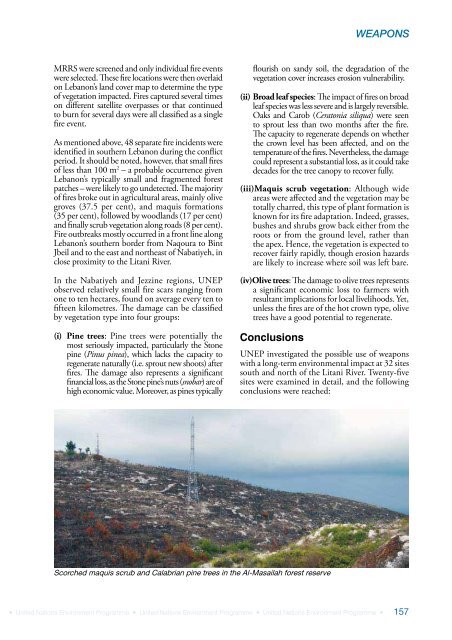Lebanon Post-Conflict Environmental Assessment - UNEP
Lebanon Post-Conflict Environmental Assessment - UNEP
Lebanon Post-Conflict Environmental Assessment - UNEP
Create successful ePaper yourself
Turn your PDF publications into a flip-book with our unique Google optimized e-Paper software.
WEAPONSMRRS were screened and only individual fire eventswere selected. These fire locations were then overlaidon <strong>Lebanon</strong>’s land cover map to determine the typeof vegetation impacted. Fires captured several timeson different satellite overpasses or that continuedto burn for several days were all classified as a singlefire event.As mentioned above, 48 separate fire incidents wereidentified in southern <strong>Lebanon</strong> during the conflictperiod. It should be noted, however, that small firesof less than 100 m 2 – a probable occurrence given<strong>Lebanon</strong>’s typically small and fragmented forestpatches – were likely to go undetected. The majorityof fires broke out in agricultural areas, mainly olivegroves (37.5 per cent), and maquis formations(35 per cent), followed by woodlands (17 per cent)and finally scrub vegetation along roads (8 per cent).Fire outbreaks mostly occurred in a front line along<strong>Lebanon</strong>’s southern border from Naqoura to BintJbeil and to the east and northeast of Nabatiyeh, inclose proximity to the Litani River.In the Nabatiyeh and Jezzine regions, <strong>UNEP</strong>observed relatively small fire scars ranging fromone to ten hectares, found on average every ten tofifteen kilometres. The damage can be classifiedby vegetation type into four groups:(i) Pine trees: Pine trees were potentially themost seriously impacted, particularly the Stonepine (Pinus pinea), which lacks the capacity toregenerate naturally (i.e. sprout new shoots) afterfires. The damage also represents a significantfinancial loss, as the Stone pine’s nuts (snobar) are ofhigh economic value. Moreover, as pines typicallyflourish on sandy soil, the degradation of thevegetation cover increases erosion vulnerability.(ii) Broad leaf species: The impact of fires on broadleaf species was less severe and is largely reversible.Oaks and Carob (Ceratonia siliqua) were seento sprout less than two months after the fire.The capacity to regenerate depends on whetherthe crown level has been affected, and on thetemperature of the fires. Nevertheless, the damagecould represent a substantial loss, as it could takedecades for the tree canopy to recover fully.(iii)Maquis scrub vegetation: Although wideareas were affected and the vegetation may betotally charred, this type of plant formation isknown for its fire adaptation. Indeed, grasses,bushes and shrubs grow back either from theroots or from the ground level, rather thanthe apex. Hence, the vegetation is expected torecover fairly rapidly, though erosion hazardsare likely to increase where soil was left bare.(iv)Olive trees: The damage to olive trees representsa significant economic loss to farmers withresultant implications for local livelihoods. Yet,unless the fires are of the hot crown type, olivetrees have a good potential to regenerate.Conclusions<strong>UNEP</strong> investigated the possible use of weaponswith a long-term environmental impact at 32 sitessouth and north of the Litani River. Twenty-fivesites were examined in detail, and the followingconclusions were reached:Scorched maquis scrub and Calabrian pine trees in the Al-Masailah forest reserve• United Nations Environment Programme • United Nations Environment Programme • United Nations Environment Programme •157
















